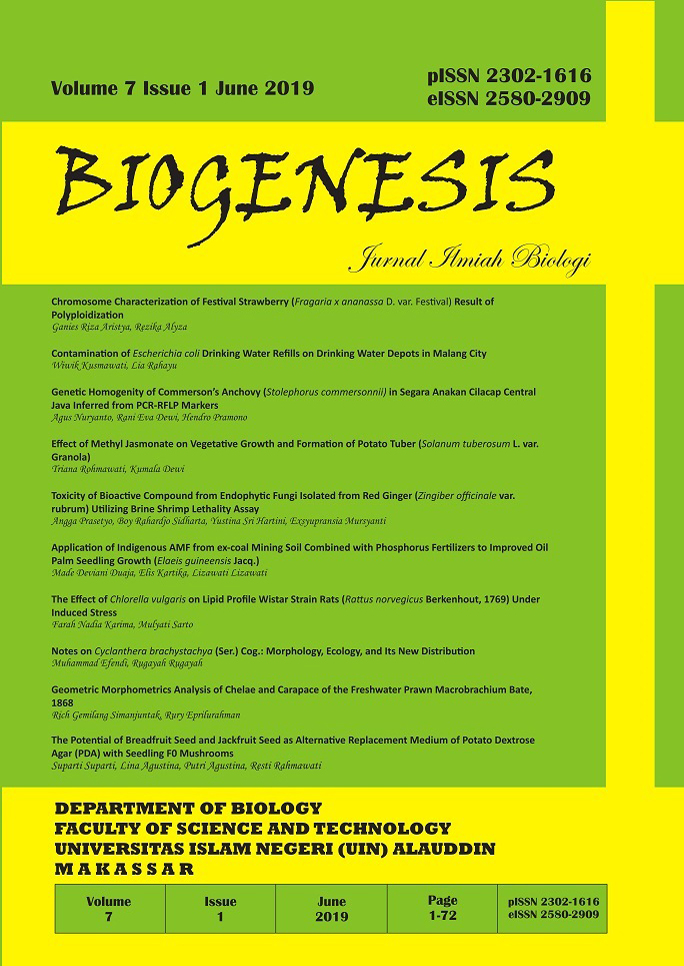Notes on Cyclanthera brachystachya (Ser.) Cog.: Morphology, Ecology, and Its New Distribution
Abstract
Cyclanthera brachystachya (Cucurbitaceae) is an exotic species in Indonesia that originated from America. This species was reported running wild in several places in Java for decade ago. However, it is limited information to support this statement. This needs to be done, because C. brachystachya have potentially to increase the genetic resources of cucumber family in Indonesia. The methods used include morphological and ecological observation, including their distribution from their naturalized habitat in Indonesia. Morphology of this specieswere described based on living material fromCibodas Botanical Garden area. Morphologically, it is not different with other morphology description on flora of Java and other literatures. In their natural habitat, they grow on open areas with high humidity levels and variously substrate. This species spreads in the mountain of West Java, from Mt. Gede Pangrango to Mt. Manglayang Bandung and Garut. A new distribution in Sumatera added outside range of this species in their origin area in Indonesia.
References
Abdulrahaman AA, Oyedotun RA, and Oladele FA. 2011. Diagnostic Significance of Leaf Epidermal Features in the Family Cucurbitaceae. Insight Botany. vol 1(2): 22-27. doi: 10.5567/BOTANY-IK.2011.22.27.
Ajuru M and Nmom F. 2017. A review on the economic uses of species of Cucurbitaceae and their sustainability in Nigeria. AJPB. vol. 2(1): 17-24. doi: 10.11648/j.ajpb.20170201.14.
Backer CA and Bakh. v/d Brink Jr. RC. 1963. Flora of Java (Spermatophytes only) vol I. Groningen, The Netherland: NVP Noordhoff. pp 306 - 307.
Dakkus PMW. 1930. An Alphabetical List of Plants Cultivated in Botanic Gardens, Buitenzorg. Bogor: Archipel Drukkerij – Buitenzorg. p. 305.
Damayanto IPGP and Muhaimin M. 2017. Notes on Chimonobambusa quadrangularis (Franceschi) Makino (Poaceae: Bambusoideae) as an invasive alien plant species in Indonesia. Floribunda. vol. 5(7): 253-257. doi: http://dx.doi.org/10.32556/floribunda.v5i7.2017.201.
de wilde JJO, and Duyfjes BEE. 2010. Flora Malesiana Seri – I: Seed Plant vol. 19. Cucurbitaceae. Bogor: Foundation Flora Malesiana. p. 333.
Efendi M, Muhaimin M., Suherman D. 2019. Sebaran populasi Cobaea scandens cav. sebagai tumbuhan invasif di Kebun Raya Cibodas dan sekitarnya. AL-KAUNIYAH: Journal of Biology. vol 12(1): 103-111. doi: https://doi.org/10.15408/kauniyah.v12i1.9033.
Fokou E, Achu MB, Kansci G, Ponka R, Fotso M, Tchiégang C, Tchouanguep FM . 2009. Chemical Properties of Some Cucurbitaceae Oils from Cameroon. Pakistan Journal of Nutrition. vol 8 (9): 1325-1334.
Jeffrey C. 1980. A review of the Cucurbitaceae. Bot. J. Linn. Soc. vol. 81: 233-247. doi: https://doi.org/10.1111/j.1095-8339.1980.tb01676.x.
Lee JM, Kubota C, Tsao SJ, Bie Z, Echevarria PH, Morra L, Oda M. 2010. Current status of vegetable grafting: Diffusion, grafting techniques, automation. Scientia Horticulturae. vol 127(2):93-105. doi: 10.1016/j.scienta.2010.08.003.
Nasution RE. 1963. An alphabetical list of plants species cultivated in the Hortus Botanicus Tjibodasensis. Bogor: Archipel. p. 65.
Pysek P, Richardson DM, Rejmanek M, Webster GL, Williamson M, Kirschner J. 2004. Alien plants in checklists and floras: towards better communication between taxonomists and ecologists. Taxon. vol 53 (1): 135. doi: https://doi.org/10.2307/4135498.
Rugayah, Retnowati A, Windadri FI, Hidayat A. 2004. Pengumpulan Data Taksonomi. In: Rugayah, Widjaja EA, Praptiwi (eds.). Pedoman Pengumpulan Data Keanekaragaman Flora. Bogor: Pusat Penelitian Biologi-LIPI. pp 5–42.
Siemonsma JS, Piluek K (eds.). 1994. Plant Resources of South East Asia. No. 8 Vegetables. Bogor: Prosea Foundation. p. 288.
Singh N, Singh B, Singh G, Thakur AK. 2015. Genus Cyclanthera Schrad. (Cucurbitaceae) in India with notes on distribution Cyclanthera brachystachya (Ser.) Cogn. in Himachal Pradesh, India. Phytodiversity. vol. 2(1): 51-55.
Teijsmann JE and Binnendijk S. 1866. Catalogus Plantarum: Horto botanico Bogoriensi. ‘Slands Plantentuin Buitenzorg. Jakarta: Ter Lands-Drukkerij. p. 426.
Van Balgooy MMJ. 2001. Malesian Seed Plants. vol 3 – Potraits of Non-Tree Families. Leiden: National Herbarium Nederland – Universiteit Leiden Branch. pp. 257.
Vainio-Mattila K. 2000. Wild vegetables used by the Sambaa in the Usambara Mountains, NE Tanzania. In Annales Botanici Fennici. vol 37(1): 57-67. New York: Finnish Zoological and Botanical Publishing Board.
Xu Z, and Chang L. 2017. Cucurbitaceae. In: Identification and Control of Common Weeds: vol 3. Singapore: Springer. doi: https://doi.org/10.1007/978-981-10-5403-7_18.
Copyright (c) 2019 Muhammad Efendi, Rugayah Rugayah

This work is licensed under a Creative Commons Attribution 4.0 International License.
COPYRIGHT AND LICENSE STATEMENT
COPYRIGHT
Biogenesis: Jurnal Ilmiah Biologi is published under the terms of the Creative Commons Attribution license. Authors hold the copyright and retain publishing rights without restriction to their work. Users may read, download, copy, distribute, and print the work in any medium, provided the original work is properly cited.
LICENSE TO PUBLISH
1. License
The use of the article will be governed by the Creative Commons Attribution license as currently displayed on http://creativecommons.org/licenses/by/4.0.
2. Author’s Warranties
The author warrants that the article is original, written by stated author/s, has not been published before, contains no unlawful statements, does not infringe the rights of others, is subject to copyright that is vested exclusively in the author and free of any third party rights, and that any necessary written permissions to quote from other sources have been obtained by the author(s).
3. User Rights
Under the Creative Commons Attribution license, the users are free to download, reuse, reprint, modify, distribute and/or copy the content for any purpose, even commercially, as long as the original authors and source are cited. No permission is required from the authors or the publishers.
4. Co-Authorship
If the article was prepared jointly with other authors, the corresponding author warrants that he/she has been authorized by all co-authors, and agrees to inform his/her co-authors of the terms of this statement.
5. Miscellaneous
Biogenesis: Jurnal Ilmiah Biologi may conform the article to a style of punctuation, spelling, capitalization, and usage that it deems appropriate. The author acknowledges that the article may be published so that it will be publicly accessible and such access will be free of charge for the readers.


